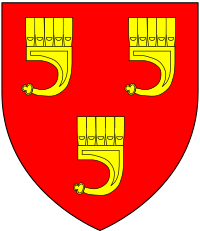Feudal barony of Gloucester facts for kids
The feudal barony of Gloucester was one of the biggest landholdings in medieval England. In 1166, it included 279 knight's fees, which were basically large estates or manors. These lands were spread out across many different counties. The main center of the barony wasn't clearly at Gloucester Castle, as that was a royal castle. However, the barony's court, where important decisions were made, was held in Bristol, Gloucestershire.
Contents
- Who Owned the Gloucester Barony?
- Before the Normans Arrived (Pre-1066)
- After the Normans Arrived (Post-1066)
- Robert FitzHamon: The Barony Begins
- Robert de Caen, First Earl of Gloucester
- William Fitz Robert, Second Earl of Gloucester
- Prince John Plantagenet Takes Control
- Geoffrey de Mandeville, Second Earl of Essex
- Hubert de Burgh, First Earl of Kent
- Amice FitzWilliam and the de Clare Family
- Gilbert de Clare, Fourth Earl of Hertford and Fifth Earl of Gloucester
- Richard de Clare, Fifth Earl of Hertford and Sixth Earl of Gloucester
- Gilbert de Clare, Sixth Earl of Hertford and Seventh Earl of Gloucester
- Gilbert de Clare, Seventh Earl of Hertford and Eighth Earl of Gloucester
Who Owned the Gloucester Barony?
Before the Normans Arrived (Pre-1066)
Brictric, Son of Algar
Even though most English feudal baronies started after the Norman Conquest in 1066, many of the lands of the Gloucester barony were held before that by a powerful Saxon lord named Brictric son of Algar. Stories say that when Brictric was young, he turned down Matilda of Flanders (who later married King William the Conqueror). Because of this, Matilda later seized his huge landholdings.
Lands in Devonshire
The barony owned many estates in Devon, a county in southwest England. The main center for these lands seemed to be at a place called Winkleigh. The lands in Devon came from several previous owners, including Brictric (and later Queen Matilda), and various Saxon lords and Norman figures like Walter de Claville.
After the Normans Arrived (Post-1066)
Robert FitzHamon: The Barony Begins
After Matilda of Flanders died in 1083, the lands she had taken from Brictric went back to the King. King William Rufus then gave these lands to his follower, Robert FitzHamon (who died in 1107). This is when the feudal barony of Gloucester truly began. Robert FitzHamon was also famous for conquering Glamorgan in Wales.
Robert de Caen, First Earl of Gloucester
Robert FitzHamon's daughter and only heir, Maud (or Mabel) FitzHamon, inherited the barony. She married Robert de Caen (who lived from before 1100 to 1147). Robert de Caen was an illegitimate son of King Henry I. King Henry I made Robert de Caen the first Earl of Gloucester in 1122.
William Fitz Robert, Second Earl of Gloucester
William Fitz Robert, 2nd Earl of Gloucester (1116–1183) was the eldest son of Robert de Caen and Maud FitzHamon. He inherited the barony. In 1166, he reported that he held 279 knight's fees. William had no surviving sons, so his three daughters—Mabel, Isabel, and Amice—became his co-heiresses. This meant they would share the inheritance, and they became wards of the crown (meaning the King looked after them and their inheritance).
Prince John Plantagenet Takes Control
When William Fitz Robert died in 1183, the barony temporarily went back to the Crown. King Henry II controlled it until 1189. In 1189, King Henry II arranged for one of William's daughters, Isabel FitzWilliam (died 1217), to marry his youngest son, Prince John (who later became King John). Prince John was then given the feudal barony of Gloucester to hold jointly with his wife Isabel.
Geoffrey de Mandeville, Second Earl of Essex
King John divorced Isabel in 1199 but kept control of the barony until 1214. Then, it passed to Geoffrey de Mandeville, 2nd Earl of Essex (around 1191-1216). King John had forced Isabel to marry Geoffrey. Geoffrey died just two years later in 1216, and the barony again went back to the Crown.
Hubert de Burgh, First Earl of Kent
After Geoffrey de Mandeville died, Isabel married Hubert de Burgh, 1st Earl of Kent (around 1160–1243) in 1217. Hubert de Burgh was a very important official called the Justiciar of England. The barony passed to him, but Isabel died later that same year in 1217.
Amice FitzWilliam and the de Clare Family
When Isabel died in 1217, the barony passed to her surviving sister, Amice FitzWilliam (died 1220). Amice was the widow of Richard de Clare, 3rd Earl of Hertford (around 1153–1217). The barony then went to her descendants, the de Clare family, who were also Earls of Gloucester. This continued until Gilbert de Clare, 7th Earl of Hertford, 8th Earl of Gloucester (1291–1314) died at the Battle of Bannockburn in 1314.
Gilbert de Clare, Fourth Earl of Hertford and Fifth Earl of Gloucester
Gilbert de Clare, 4th Earl of Hertford (around 1180-1230) also became the 5th Earl of Gloucester. He married Isabel Marshal in 1217 and was recognized as Earl of Gloucester in 1218.
Richard de Clare, Fifth Earl of Hertford and Sixth Earl of Gloucester
Richard de Clare, 5th Earl of Hertford and 6th Earl of Gloucester (born August 4, 1222 – died July 14, 1262), continued the family's ownership.
Gilbert de Clare, Sixth Earl of Hertford and Seventh Earl of Gloucester
Gilbert de Clare, 6th Earl of Hertford, 7th Earl of Gloucester (1243–1295) was the next in line.
Gilbert de Clare, Seventh Earl of Hertford and Eighth Earl of Gloucester
Gilbert de Clare, 7th Earl of Hertford, 8th Earl of Gloucester (1291–1314) was the last of this line to hold the barony. When he died, his two sisters, Eleanor de Clare (died 1337) and Margaret de Clare (died 1342), became the co-heiresses to the feudal barony of Gloucester.


